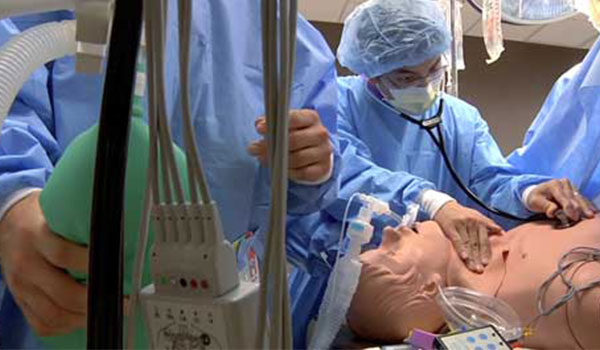

In my first post, I addressed the larger, more philosophical issues that need to be addressed when designing a Simulation Center. In this post, I take a more in depth look at specific elements of the Simulation Lab.
How should your process flows be organized? The different processes and traffic flows throughout the simulation lab should be planned to allow a segregation of on-stage and off-stage functions and personnel. While there are many nuances, the basics to consider include:
- Standardized Patients should be located to allow pre-simulation planning with coordinators and instructors in an area that is restricted to students. It is also desirable to provide a pathway from this prep area to the simulation rooms that does not mingle with student traffic.
- Students will most likely have several different processes that should be mapped and accommodated. Functions such as checking-in for an exam, attending lectures, receiving debriefs, or conducting independent lab work assignments all have their unique requirements, privacy protocols, and segregation requirements.
- Technicians / AV Staff in almost all cases should remain hidden from students while being easily accessible to instructors.
- Instructors should be able to craft their visibility level to fit any situation that arises. They should have freedom of movement throughout the spaces and should be able to remain hidden until they want to be seen – ultimate flexibility is the driving force.
Segregation planning for proper flows can increase the circulatory area required for your simulation lab, but the sense of realism (and process efficiency) that can be gathered is usually worth the expenditure.
Which method of observation best supports your teaching techniques? Almost every simulation environment will integrate some level of technology that includes cameras and microphones for student observation and documentation. However, regardless of the sophistication of these systems, adequate provisions for “live” instructor observation are usually required. Knowing which strategy is most aligned with the way you want to teach is a key component in the lab layout:
- Headwall Strategy places the observation team in an adjacent room at the headwall of the simulation room and is the most common arrangement. This arrangement allows for the most direct line-of-sight between the instructor and the student and is usually accomplished with one-way mirrors so the instructor is not visible to the student. Potential drawbacks to this position include interference with headwall equipment and making the students feel as if they are in a fishbowl.
- Footwall Strategy places the observation team in a room outside the footwall of the simulation room. While this solution is the most unobtrusive of the “live” observation scenarios from the student’s perspective, the views that the instructor has are often compromised and/or focused on the back of the student.
- In-Room Strategy places the observers inside the simulation room. While this strategy does allow for flexible viewpoints, it detracts significantly from the realistic care environment and is not usually the preferred solution.
- Remote Strategy removes direct observational provisions from the room completely in favor of remotely controlled cameras and microphones. This strategy allows the simulated environment to most realistically recreate the real patient environment but is completely reliant on technology (and often makes the instructor feel disconnected from the process).
Each strategy will have implications to the student, instructor and standardized patient traffic flows when planning the lab. Regardless of the observation location, some flexibility to accommodate multiple observation types will enable one environment to accommodate multiple instructor preferences and teaching methodologies to maximize the benefit to your students.
In my third and final post, I’ll address how the Simulation Center can be designed to facilitate learning and how you can accommodate industry and technology advancements.
Continue to Part 3 of 3 Here.





Pingback: Simulation Centers Can Lead the Way to Improved Efficiency, Part 1 of 3 | Array Architects